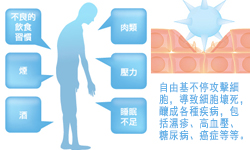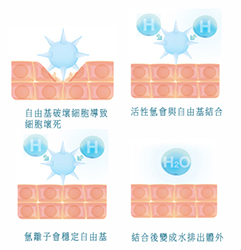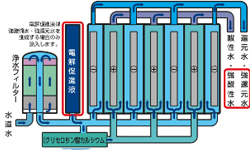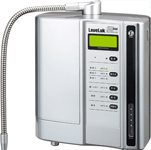
Acidic Water
Water produced at the positive electrode is known as acid water (or oxidized water). In general, acidic water is unsuitable for drinking, but it has astringent properties for the skin, which makes it a good facial cleanser (especially weak acid water). Strong acid water is a powerful disinfectant; it even kills antibiotic-resistant staphylococcus and salmonella. Moreover, since it immediately turns into ordinary water after use (20H = H20 + 0) there is no need to clean up after disinfecting, unlike other disinfectants, which makes it more efficient and environmentally friendly.
- Disinfects hands, clean cuts and wounds; helps stop bleeding.
- When used as mouthwash, prevents bleeding of the gums.
- May heal Eczema, Athlete's foot and Hemorrhoids.
- Effective in toning and firming skin after face washing; prevents pimples and helps eliminate scars.
- Softens and moisturizes dry skin and hair.
- When used to wash fruits and vegetables, meat, and seafood before freezing, helps retain flavor while thawing.

Kangen Water
The negative electrode produces active hydrogen water, which contains large quantities of active hydrogen and has strong reducing or anti-oxidant properties. We call this kangen water; it has a pH of 8.5-9.5. The active hydrogen in kangen water reacts with the active oxygen in the body to produce harmless water. Thus, kangen water is very beneficial to bodily health; it has smaller clusters which can be more easily absorbed by our body.
Kangen water offers immediate health benefits by removing active oxygen from the system. It also offers preventive medical benefits in terms of overall health improvement and metabolic enhancement simply because it is a high quality drinking water.
- Improve digestion and metabolism
- Clean waste substance in blood
- Lower blood sugar and dissolve grease, prevent diabetes and obesity.
- Stabilize sugar level in blood, cleanse and soften vein, prevent angiosclerosis, hypertension and stroke.

What Free Redical Is
Radicals (often referred to as free radicals) are atoms, molecules, or ions with unpaired electrons on an open shell configuration. Free radicals may have positive, negative, or zero charge. With some exceptions, the unpaired electrons cause radicals to be highly chemically reactive.
Radicals, if allowed to run free in the body, are believed to be involved in degenerative diseases, senescence (the aging process), and cancers.
The two most important oxygen-centered free radicals are superoxide and hydroxyl radical. They derive from molecular oxygen under reducing conditions. However, because of their reactivity, these same free radicals can participate in unwanted side reactions resulting in cell damage. Excessive amounts of these free radicals can lead to cell injury and death, which results in many diseases such as cancer, stroke, myocardial infarction, diabetes and major disorders. Many forms of cancer are thought to be the result of reactions between free radicals and DNA, resulting in mutations that can adversely affect the cell cycle and potentially lead to malignancy. Some of the symptoms of aging such as atherosclerosis are also attributed to free-radical induced oxidation of many of the chemicals making up the body. In addition free radicals contribute to alcohol-induced liver damage, perhaps more than alcohol itself. Radicals in cigarette smoke have been implicated in inactivation of alpha 1-antitrypsin in the lung. This process promotes the development of emphysema.
Free radicals may also be involved in Parkinson's disease, senile and drug-induced deafness, schizophrenia, and Alzheimer's[9]. The classic free-radical syndrome, the iron-storage disease hemochromatosis, is typically associated with a constellation of free-radical-related symptoms including movement disorder, psychosis, skin pigmentary melanin abnormalities, deafness, arthritis, and diabetes mellitus. The free radical theory of aging proposes that free radicals underlie the aging process itself, whereas the process of mitohormesis suggests that repeated exposure to free radicals may extend life span.
Active Oxygen
Ordinary oxygen exists as a pair bond between two oxygen atoms, represented by chemical symbols as O2. This pair bond is stable. However, active oxygen consists of a single non-bonded oxygen atom. In this state, oxygen is very unstable. It will bond easily with other substances during the oxidation process.
The body itself produces active oxygen under a variety of conditions. Among these conditions are coprostasis (long-term buildup of fecal matter in the intestines) and malodorous stools. Solar ultraviolet radiation also forms active oxygen when it strikes water molecules (H20). Thus around 2-5% of the oxygen we breathe in consists of active oxygen.
Active oxygen does have some beneficial effects for our body, but it has more harmful than beneficial effects. The reason is that active oxygen is a toxin. One reason why we get sunburned at the beach is that ultraviolet rays produce active oxygen that damages the melanin in our skin. Frequent and severe sunburn can lead to skin cancer.
When we hang out our duvet blankets to air in the sun, ultraviolet rays strike the moisture content (not just liquid) in the blanket and produce active oxygen. In turn, the active oxygen kills bacteria mold, ticks and fleas in the blanket. However, some active oxygen remains inside the blanket while it is still warm from the sunlight, so we shouldn't cover ourselves with it right away to prevent excess intake of active oxygen into our body.
Moreover, many normal activities produce active oxygen within our body including breathing, eating and exercising. Smoking also produces a lot of active oxygen. In a beneficial way, the active oxygen kills harmful bacteria. However, if there is too much active oxygen, it will also attack the normal cells and turn them into cancerous ones. If they attack the islets of Langerhans, insulin production will be disrupted causing diabetes. Most important, the body is being oxidized (aging), and aging is actually a disease.
Furthermore, active oxygen attacks the DNA in the cell nuclei. This causes mutations in the three billion nucleotides present in human DNA. Recently, researchers have shown that this is the cause of a variety of human illnesses and other maladies. Because active oxygen has such a powerful bonding capability, it will bond with and oxidize virtually anything. Oxidation changes the chemical properties of substances, and causes the degradation of plastic, textiles, and dyes
Active Hydrogen
Active hydrogen bonds with active oxygen to form harmless water molecules. Water that contains large amounts of active hydrogen is known as ionized water.
As we saw with active oxygen, ordinary hydrogen consists of a pair bond between two hydrogen atoms, represented in chemical symbols as H2. While active hydrogen consists of a single unbonded hydrogen atom, these single hydrogen atoms have extremely powerful capabilities in reducing, or anti-oxidizing which means they can chemically reduce other substances. When active hydrogen comes in contact with excess active oxygen in the body, it immediately bonds with the active oxygen to form water. Thus it removes active oxygen from the body and it does so harmlessly with no side effects. Active hydrogen reacts strongly with many substances, but particularly with oxygen. There are other materials beside ionized water that has a "scavenger" effect to remove excess active oxygen. The most prominent of these is super oxide dismutase or SOD. However both the quantity and effectiveness of SOD in the body diminishes with age. This means that we need to think about supplementing it, and the ideal supplement is active hydrogen.
Note: Scavenger enzymes are enzymes that prevent active oxygen from bonding with and oxidizing other substances.

How Kangen Water Improves Health
Kangen Water Neutralizes Free Radicals
Free Radicals cause our bodies' aging process. But there is a simple method to neutralize these Free Radicals. Kangen water neutralizes free radicals in our bodies with its anti-oxidizing nature.
Kangen Water Helps to Restore Healthy pH Balance
Our bodies' pH balance is extremely important! But our lifestyles are constantly attacking our own cells. Kangen water helps to restore the healthy pH balance in our body cells. Our lifestyles are slowly killing ourselves. Stress, processed foods, soft drinks and dehydration are putting huge amount of burden on our body. It's well known in the medical community that an overly acidic body is the root of many common diseases. Kangen water counteracts the acidic foods and environment that our bodies endure every single day, helping your body to stay healthy.
Kangen Water Helps Detoxification
The colon is the last portion of the digestive system; it extracts water and salt from solid wastes before they are eliminated from the body. Excessive animal proteins, dairy products, alcohol, saturated fats as well as other materials prevent our colons from absorbing vital nutrients for our body usage. Kangen water helps detoxification in our bodies by cleaning our colons.


